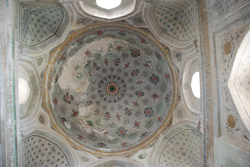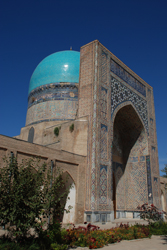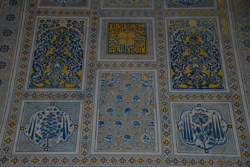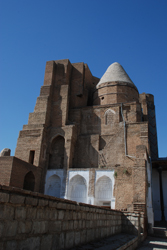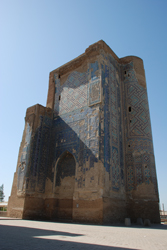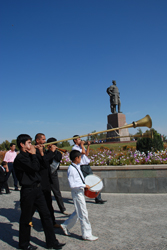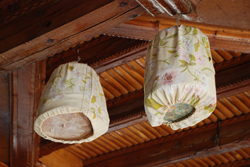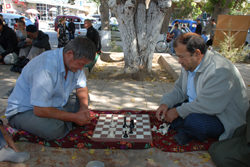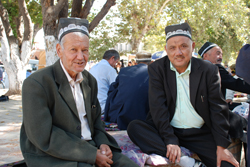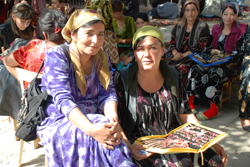Shakhrisabz: Chaihane Culture
8 October, 2008, 03:16 am in "Uzbekistan"
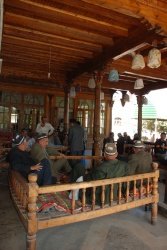 After perhaps over-bargaining for a shared taxi, we finally got on the road. Over-bargaining is when you get the price as low as it will probably go then waste time trying to get it lower. Or, eventually getting it a little lower but getting a bit screwed in the end. But who knows? Maybe if we paid the full price, the driver still wouldn't have taken us all the way. Anyway, the driver took us a little ways into Shakhristan and dropped us off at a bazaar which wasn't the central bazaar we had asked for. We started walking and realized we'd gone more than 300 meters without seeing a sign of Timurid architecture. When Rowshan asked we learned it was still a couple km away. So we caught a mashrutka to the center and once again were in business.
After perhaps over-bargaining for a shared taxi, we finally got on the road. Over-bargaining is when you get the price as low as it will probably go then waste time trying to get it lower. Or, eventually getting it a little lower but getting a bit screwed in the end. But who knows? Maybe if we paid the full price, the driver still wouldn't have taken us all the way. Anyway, the driver took us a little ways into Shakhristan and dropped us off at a bazaar which wasn't the central bazaar we had asked for. We started walking and realized we'd gone more than 300 meters without seeing a sign of Timurid architecture. When Rowshan asked we learned it was still a couple km away. So we caught a mashrutka to the center and once again were in business. I guess we are suffering from Timurid architecture overload. Another turquoise tile dome, more ornate tile-work on brick building, more highly decorated painted interiors. We glanced at the tombs, the iwan and area inside of Kok Gumbol--the mosque. The painting was comparatively unique since instead of being completely covered with designs, there were walls of rectangular panels with paintings inside. The tome paintings were also different. The courtyard/medressa was full of souvenir sellers.
We rushed past and went to the Khazrat Imam complex behind. It was a ruined brick building with some remains of a foundation. We glanced into a rather un-ornate tomb and a guy tried to sell us tickets. We decided he was probably a fake since his tickets weren't in a book (looked like the paper was too white (photocopied) instead of the usual ones printed on newsprint.) That and the site was supposed to be free. He was also annoying so we ignored him. Later we passed him again sitting at a souvenir table.
We walked back North through the town glancing at a caravansaray and mosques on the way. The Ak Saray (White Palace) isn't white and not much remains of the former huge complex. Upon the ruins, a large park complex has been built. The area had an atmosphere of a carnival. There was even a ferris wheel visible beyond the ruins! Around the park were cafes blasting music, crowds of tourists pouring back into tour buses and a couple wedding parties. A large statue of Timur dominates the center and serves as a backdrop for wedding photographs.
What remained of the palace was beautiful. It was the tall brick ruins of what perhaps had been an entrance tower. We didn't go up but we did admire the beautiful remains of the blue and white tile-work which covered some of the surfaces.Outside of the tower, we saw a group of musicians playing for a wedding party—long horns, a zurna type instrument, a nagara and another drum.
What remained of the palace was beautiful. It was the tall brick ruins of what perhaps had been an entrance tower. We didn't go up but we did admire the beautiful remains of the blue and white tile-work which covered some of the surfaces.Outside of the tower, we saw a group of musicians playing for a wedding party—long horns, a zurna type instrument, a nagara and another drum.
We decided to walk back to the center and get lunch at a very crowded chaihane. We ordered plov, tea and took a seat on a tea bed inside an enclosed wooden patio. The patio had ornate carved wooden pillars and ceilings. The plov was yummy and people working there were friendly. It was here we realized Shakhrisabz is more Uzbek than Tajik. Rowshan had to switch to Azeri instead of the Farsi he'd been using in Samarkand. On the main part of the patio which was completely open on the sides, the tea beds were full with mostly groups of men-- many older. Hanging from the ceiling were rows of covered bird cages. One of the men told Rowshan the birds were called budani and at 7PM the cages were uncovered and the birds woke up and sang (kind of like Disney's Tiki Room!). The man said he and his friends liked to relax by just sitting and watching the birds. Even without the birds, our lunch at the chaihane had revived us and made us feel happier about people. There is something very refined and gentlemanly about the chaihane. People casually talk and are friendly but you don't have to worry that they want anything from you besides conversation.
The area in front of the chaihane was also crowded. Men sat on platforms which had been placed on brick walls which housed trees. A couple men were playing chess. Rowshan got into a conversation with one of the spectators. Rowshan asked him if he played and the man replied, “only for money.” Rowshan joked, calling him Kasparov, “So you've already won everyone's money here.” The other men laughed. Another man told Rowshan he'd traveled to Iran and Konya (Turkey).
Next to the chaihane patrons, a group of Uzbek women in jewel colored velvets decorated with flowers and sparkles, wold jewelry from little portfolios they pulled out of their purses. We left with a good impression of Shakhrisabz, wishing there were more traditional chaihanes left in Uzbek cities.
Comments
- Comments
Powered by My Blog 1.69. Copyright 2003-2006 FuzzyMonkey.net.
Created by the scripting wizards at FuzzyMonkey.net..
(Code modified by Rowshan Dowlatabadi)
Created by the scripting wizards at FuzzyMonkey.net..
(Code modified by Rowshan Dowlatabadi)


